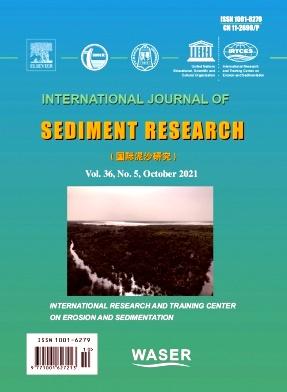Impacts of grade control structures on riverbed degradation
IF 3.7
2区 环境科学与生态学
Q2 ENVIRONMENTAL SCIENCES
引用次数: 0
Abstract
Sediment flux of many rivers has been significantly reduced due to human activities caused by economic development, leading to increasingly severe riverbed degradation. To prevent riverbed degradation, grade control structures (GCSs) have been widely applied in degrading channels. Existing studies have not provided a good understanding of the effects of GCSs on flow characteristics and bed morphology in degrading channels, limiting the management of degrading channels. A series of flume tests with no sediment supply are conducted to investigate the effects of GCSs on upstream water levels and riverbed morphology in degrading channels. The experimental results indicate that: (1) in the initial stage of degradation, the water surface slope in the backwater reach is linearly and negatively correlated with the GCS-height Froude number, based on the average flow velocity upstream of the backwater reach due to GCS and the height of GCS; (2) the effective protection bed length upstream of GCS is approximately equal to the length of the reach where the flow velocity is less than the critical velocity for sediment motion in the backwater zone; (3) for sequential GCSs, the effective protection bed length will decrease if GCS is located in the backwater reach of the downstream GCS. A semi-analytical calculation method of the effective protection length and equilibrium bed profile upstream of GCS in degrading channels is proposed based on the critical condition of sediment motion and weir flow formulas. The computed values by the proposed calculation method agree well with the experimental data of the present study.
等级控制结构对河床退化的影响
由于经济发展引起的人类活动,许多河流的输沙通量显著减少,导致河床退化日益严重。为防止河床退化,坡度控制结构(GCSs)被广泛应用于退化河道。现有研究尚未很好地了解gcs对降解河道流动特性和河床形态的影响,限制了降解河道的管理。在无输沙条件下进行了一系列水槽试验,研究了gcs对退化河道上游水位和河床形态的影响。实验结果表明:(1)在退化初期,基于回水河段上游GCS平均流速和GCS高度,回水河段水面坡度与GCS-高度弗劳德数呈线性负相关;(2) GCS上游有效保护河床长度近似等于回水区流速小于泥沙运动临界流速的河段长度;(3)对于序贯式GCS,如果GCS位于下游GCS的回水河段,则有效保护层长度会减小。基于泥沙运动的临界条件和堰流公式,提出了一种退化河道中GCS上游有效防护长度和平衡河床剖面的半解析计算方法。所提计算方法的计算值与本研究的实验数据吻合较好。
本文章由计算机程序翻译,如有差异,请以英文原文为准。
求助全文
约1分钟内获得全文
求助全文
来源期刊
CiteScore
6.90
自引率
5.60%
发文量
88
审稿时长
74 days
期刊介绍:
International Journal of Sediment Research, the Official Journal of The International Research and Training Center on Erosion and Sedimentation and The World Association for Sedimentation and Erosion Research, publishes scientific and technical papers on all aspects of erosion and sedimentation interpreted in its widest sense.
The subject matter is to include not only the mechanics of sediment transport and fluvial processes, but also what is related to geography, geomorphology, soil erosion, watershed management, sedimentology, environmental and ecological impacts of sedimentation, social and economical effects of sedimentation and its assessment, etc. Special attention is paid to engineering problems related to sedimentation and erosion.

 求助内容:
求助内容: 应助结果提醒方式:
应助结果提醒方式:


